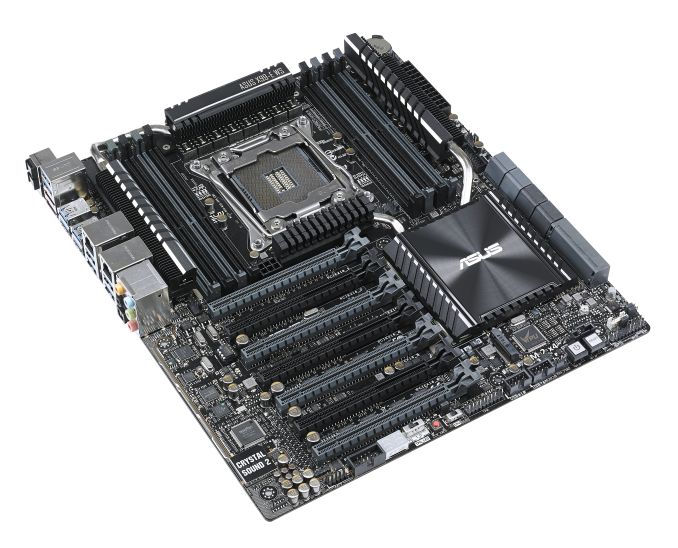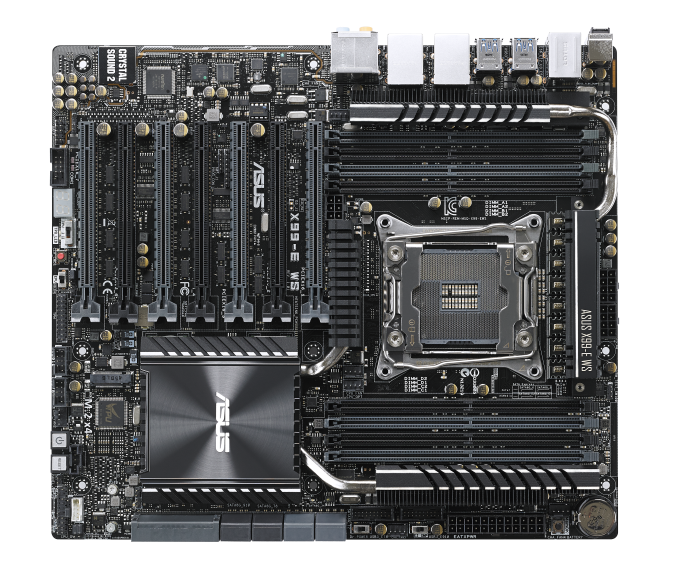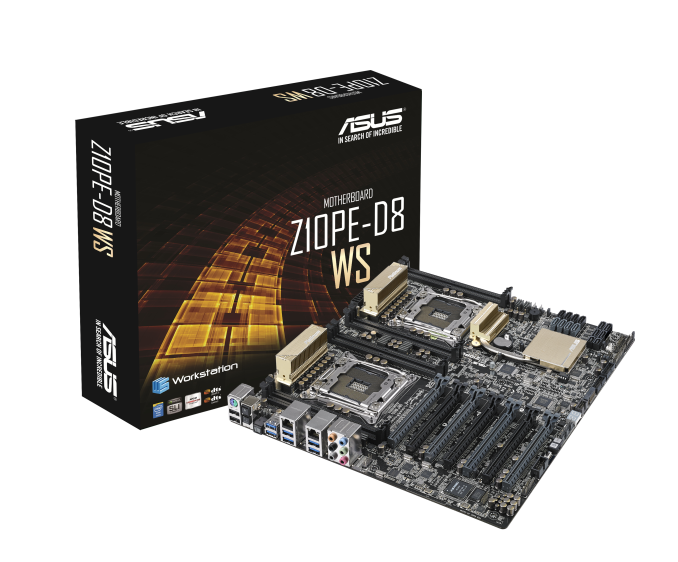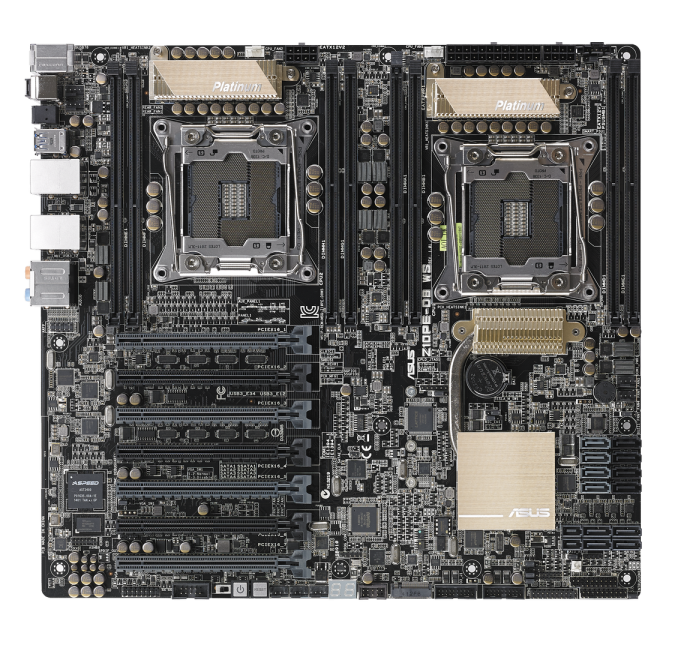ASUS Announces Haswell-E Workstation Motherboards: X99-E WS (1P) and Z10PE-D8 WS (2P)
by Ian Cutress on September 15, 2014 8:00 AM EST- Posted in
- Motherboards
- Asus
- Workstation
- Enterprise
- X99

The normal route for workstation level motherboards is from the server business unit of a motherboard manufacturer, which then works its way into full systems rather than being sold separately. The other, less used alternative is for the mainstream end-user motherboard business units to develop their own and sell directly to end-users building their own workstation. While some of the motherboard manufacturers are slowly jumping on this bandwagon, ASUS has been at it for a number of generations now, with enough success to continue into their new Haswell-E designs which have just been announced.
ASUS X99-E WS
The X99-E WS follows on from the X79-E WS and the X58-E WS, and the most obvious thing to notice is the seven full-length PCIe slots. ASUS’ workstation line of motherboards, as I was told during my time at their HQ, is focused at maintaining compatibility and function with as many different types of PCIe devices possible. This includes RAID cards, PCIe storage, video capture cards, PCIe co-processors, FPGAs, normal GPUs and any other form of throughput accelerant. In order to assist with bandwidth, it would seem that this motherboard uses a PLX chip to give a full PCIe 3.0 x16/x16/x16/x16 for four-way or x16/x8/x8/x8/x8/x8/x8 when all the slots are populated.
The system includes exclusive Beat Thermal Chokes (v2), 12K capacitors and enhanced power connectors. For onboard storage, M.2 x4 is supported along with dual SATA Express and ASUS’ PIKE II (Proprietary I/O Kit Expansion). Thunderbolt support is also provided via the onboard header. Networking comes via a dual Intel solution (I210-AT and I218-LM) with audio from a Realtek ALC1150. ASUS’ WS line of motherboards includes maintenance tools such as the Q-Code Logger and Dr. Power, the latter being for power supply monitoring.
While pricing and release date has not been released yet, we expect the X99-E WS to be in the $520 price bracket and should be available in North America in the next few weeks. Note that this motherboard acts more like an end-user product, and thus comes without AST2300/IPMI monitoring tools. This would lower the price, however the upshot is an enhanced BIOS/software package more akin to a consumer level product than a server one.
ASUS Z10PE-D8 WS
The dual processor line of motherboards is typically the mainstay for system builders alone, but over the years various manufacturers have floated the concept of an end-user model. This is shown by our recent increase 2P motherboard reviews. The main barrier here is that to take advantage of a 2P system, Xeons get promoted to the main cost. For home-users, that cost is largely prohibitive however for the prosumer or small-business IT specialist, it becomes part of the business cost instead. With Ivy Bridge-E, the Z9PE-D8 WS seemed to be well received, and thus the Z10PE-D8 WS launch seems a logical choice.
Using the SSI EEB form factor, this motherboard supports one DIMM per channel but has the full array of PCIe 3.0 x16 slots similar to the X99-E WS. It would seem that UDIMMs are not supported here, although the specification list does mention up to 512GB RDIMM/LRDIMM/NVDIMM support. The motherboard is based on the C612 chipset, which is the primary chipset for most workstation 2P motherboards. Storage comes via 12 SATA ports with two SATA Express and M.2 x4 support as well. Similar to the X99-E WS, Beat Thermal Chokes and 12K capacitors are being used here as well. This time the WS motherboard does have management via an AST2400.
One of the more interesting features from ASUS’ PE line of WS motherboards has always been the ability to overclock using the BCLK, to which extent ASUS is promoting a potential 10% improvement in performance using their OC Tuner and Xeon Turbo Charger platform. We’ve tried testing some Xeons in house in a 1P environment and only achieved 4-7%, so it would be interesting to see this in action and observe what else is adjusted.
The Z10PE-D8 WS will be priced at $599 and will be available soon.


















33 Comments
View All Comments
Pissedoffyouth - Monday, September 15, 2014 - link
If Intel made a skulltrail2 motherboard which let you use regular i5s and overclocj etc they'd make a killing with the crowd who pay thousands for the best over clocked systems.haikuginger - Monday, September 15, 2014 - link
You're forgetting that the original Skulltrail platform only ever allowed one model of CPU to work. The Core 2 Extreme QX9775, with LGA 771 and a $1500 price tag, was, for all intents and purposes, a Xeon in everything but name. Especially when you consider that Skulltrail required FB-DIMMs.TiGr1982 - Monday, September 15, 2014 - link
That's not currently possible, because current CPUs for LGA1150 (regular i5 among them) don't have QPI for dual socket configurations, and, thus, support only single socket operation.To do dual socket with i5's, Intel will have to release special i5 with QPI.
Needless to say, this won't happen.
3ch3l0n - Monday, September 15, 2014 - link
The Skultrail could/can take "cheaper" than QX9775 Xeons of the time. Even now it is a very cheap way to get dual CPUS running .. the coolest thing about it though ..was Coolit's designed for SkullTrail Tec cooler .. that kept my QX9775 running at 17 to 20 degrees C..under load! the Z10PE is the spiritual continuation of skulltrail, even now two 6 core 3.5ghz Xeons don't come too much north of 1 X99 8 core 5960x and you can go lower/cheaper if you need 2 CPUs with the new Xeons.. right now I am looking to finally sell mine and move to the E WS or the D8 .. you don't have to go for the 4K costing 18 core CPU (x2) ..extide - Monday, September 15, 2014 - link
But the skulltrail did still take Xeon's and not regular off the shelf Core 2 Quad's, and of course the QX9775's.Seems like going with just a single E5 2687W v3 would be a pretty decent box. I wouldn't go with the 18-core 2699 v3's for a workstation, though, I mean, even if they weren't extremely expensive. The 2687W v3's are like $2k each anyways....
eanazag - Monday, September 15, 2014 - link
AMD's server road map indicates a 2P APU server, which means two processors with integrated GPUs. This could be interesting in they price it right. Maybe built-in crossfire on what amounts to two 7850K's.bunnyfubbles - Monday, September 15, 2014 - link
the crowd who pays thousands wouldn't be interested in a dual CPU system using mainstream chipsif we're fantasizing about things that aren't going to happen, it would make a lot more sense to fantasize about an unlocked 10-18 core s2011-3 Xeon that would make any such dual i5 look like a complete joke and would also be far more likely to see considering that 10-18 core Haswell-EP chips actually exist while dual s1150 boards/CPUs do not exist.
kwrzesien - Monday, September 15, 2014 - link
Ian,Thanks, a nice head's up on some new boards. I take it they support ECC memory with Xeons, but these should also run with i7's right?
And I like the placement of the M.2 slot in the lower-left corner by the PCH and reboot button on the X99-E, it's easily accessible even once installed and loaded with some PCIe. Also notice that there are TWO CPU 8-pin power connectors and a 6-pin PCIe extra power connector tucked around the CPU socket. I can't imagine why a Xeon would need two CPU power connectors if it can't be overclocked other than BLCK.
colinstu - Monday, September 15, 2014 - link
no i7sIan Cutress - Monday, September 15, 2014 - link
The X99-E WS will support i7s, but the Z10PE-D8 W8 will not. Only the Xeon E5-26xx v3 series is aimed at 2P motherboards and have the valid QPI links.The best way to check with ASUS motherboards is go to the product page, click support, then click CPU Support:
http://www.asus.com/Commercial_Servers_Workstation...
http://www.asus.com/Commercial_Servers_Workstation...